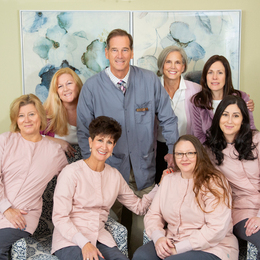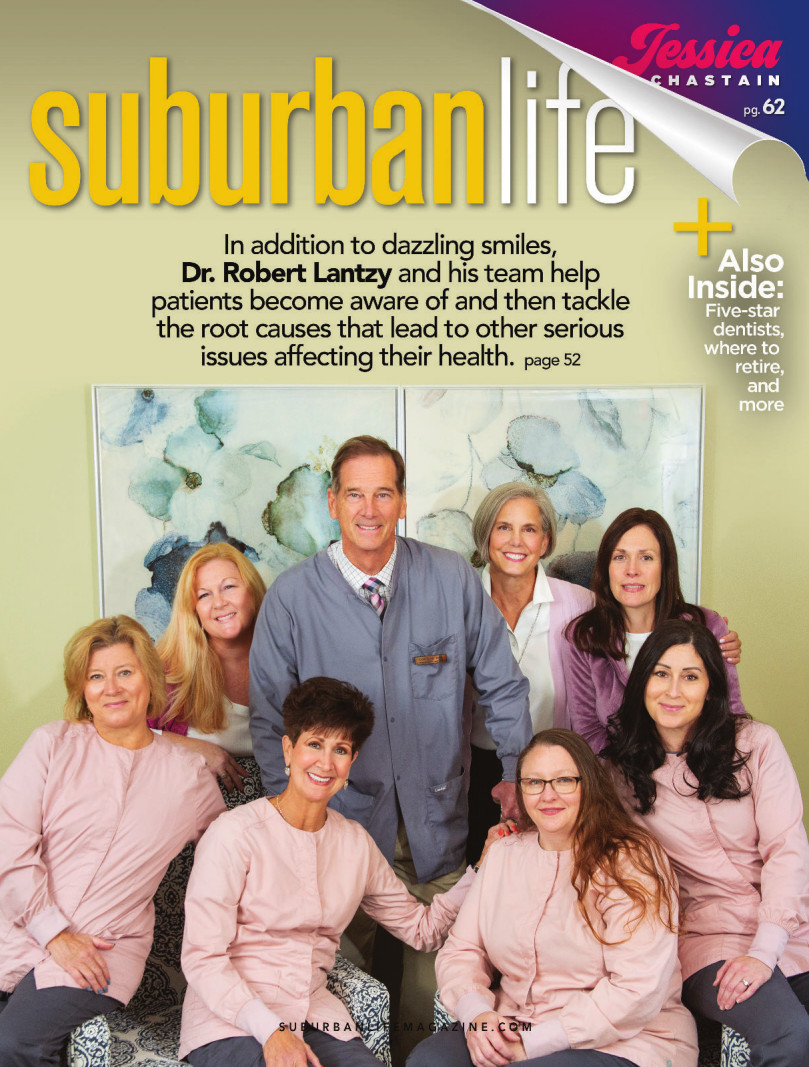
More Than a Pretty Smile
In addition to dazzling smiles, Dr. Robert Lantzy and his team help patients become aware of and then tackle the root causes that lead to other serious issues affecting their health.
Robert A. Lantzy, D.M.D., has spent his career creating stunning smiles for his patients, but improving the health, function, and aesthetics of the smile is just the tip of the iceberg.
“We focus on all of you, not just your teeth and gums,” says Dr. Lantzy, who has been leading his Bucks County-based dental practice for nearly 35 years. “We do a thorough medical history to learn what other things may be tied to problems expressed in the mouth. We also take each patient’s blood pressure regularly. Why? We have made many people aware of present, dangerously undiagnosed hypertension, uncontrolled diabetes, and breathing disorders.”
Dr. Lantzy considers himself a practitioner of “complete health dentistry.” One area of increasing importance involves the underdevelopment of the structures on which a smile is built—namely, the jaws and bones of the midface.
“I see patients every day with head and neck pain, jaw/joint issues, disrupted sleep, fatigue, and other chronic ailments,” he says. “More often than not, the root cause of these kinds of problems is an underdevelopment of the midface and jaws, combined with dysfunctional breathing.”
Dr. Lantzy offers a comprehensive menu of nonsurgical gum care, clear aligner orthodontic therapy, cosmetic dentistry, and full-mouth restorative dentistry services. This includes everything from teeth cleaning and fillings to teeth whitening, and from dental crowns, veneers, and dental implants, to full smile makeovers. With every patient, he underscores the link between oral health and overall health—the mouth-body connection, as it’s known.
“Mother Nature created a beautiful machine—the human body,” he adds. “As beautiful as it is, one little thing does affect another. Once bacteria from the mouth gets into the bloodstream, it has free run in the whole body. The presence of periodontal disease adds to the inflammatory burden of the whole body and complicates serious conditions including coronary artery disease, respiratory disease, rheumatoid arthritis, and problems controlling blood sugar in diabetes.”
We spoke with Dr. Lantzy about the reasoning behind the evolution of his practice, the causes of structural underdevelopment and dysfunctional breathing, and the options patients have for treating the serious conditions that often result.
Q&A
You mentioned that many patients’ problems are associated with dysfunctional breathing and the underdevelopment of the midface and jaws. I imagine you must often hear questions along the lines of, “What does dysfunctional breathing have to do with dentistry?”
Proper jaw development and proper breathing go hand in hand. One affects the other. Through our advanced training and through our comprehensive dental exam, especially using cone beam computed tomography, we see the oral manifestations of dysfunction. The mouth is our wheelhouse. In dentistry, we relate grinding, crowded teeth, gum disease, mouth breathing, scalloped tongue—these are all signs of underdeveloped jaws and signs of breathing disorder. Where needed, we do further assessments.
You mentioned that many patients’ problems are associated with dysfunctional breathing and the underdevelopment of the midface and jaws. I imagine you must often hear questions along the lines of, “What does dysfunctional breathing have to do with dentistry?”
Proper jaw development and proper breathing go hand in hand. One affects the other. Through our advanced training and through our comprehensive dental exam, especially using cone beam computed tomography, we see the oral manifestations of dysfunction. The mouth is our wheelhouse. In dentistry, we relate grinding, crowded teeth, gum disease, mouth breathing, scalloped tongue—these are all signs of underdeveloped jaws and signs of breathing disorder. Where needed, we do further assessments.
This can be rather complex. It may involve other medical disciplines, such as otolaryngologists (ENT doctors) and chiropractors, among others, to see if your airway is structurally sound for you to breathe in the first place. Some people may need to see a myofunctional therapist for oral and facial muscle therapy to help with proper breathing or after a frenectomy for patients who were tongue tied. Others may need the attention of allergists, nutritionists, and other specialists. We can be your coach through all of this.
What are the causes of dysfunctional breathing?
Nasal breathing is the norm, and it has many benefits: the exchange of oxygen and carbon dioxide, purifying and humidifying the air, etc. Mouth breathing is the result of epigenetics, or how our behaviors and environment affect the way our genes are expressed. The processed foods we eat, the air we breathe, the medications we take, the water we sip, the exercise we are not getting—all of these factors contribute to the lack of growth and development of the upper and lower jaws that cause improper breathing.
Nasal breathing is the norm, and it has many benefits: the exchange of oxygen and carbon dioxide, purifying and humidifying the air, etc. Mouth breathing is the result of epigenetics, or how our behaviors and environment affect the way our genes are expressed. The processed foods we eat, the air we breathe, the medications we take, the water we sip, the exercise we are not getting—all of these factors contribute to the lack of growth and development of the upper and lower jaws that cause improper breathing.
Sleep apnea seems to be a growing epidemic. CPAP therapy is often prescribed to treat sleep apnea, but I understand some people do not tolerate it well. Are there other viable options?
CPAP is the standard of care for moderate to severe sleep apnea, while oral appliances that position the lower jaw forward can be used for mild to moderate sleep apnea. Both of these options are prescribed for a lifetime, because they do not treat the problem; they just help you get more oxygen.
CPAP is the standard of care for moderate to severe sleep apnea, while oral appliances that position the lower jaw forward can be used for mild to moderate sleep apnea. Both of these options are prescribed for a lifetime, because they do not treat the problem; they just help you get more oxygen.
There are surgical treatment options. One is called Inspire, which is an implant in your body somewhat like a pacemaker, but the efficiency of that is questionable. Another option is uvulectomy, where a surgeon will laser part of your uvula and soft palate to open the airway; it’s considered quite painful and not always successful. You could also have your jaws surgically broken and advanced forward, in such a way to permanently open your airway. If one can avoid surgery, why not?
One nonsurgical, noninvasive option is a removable dental appliance that can be made to stimulate the natural growth of your midface and jaws and increase the volume of your airway. In most cases, this appliance can minimize or even eliminate the dependency on CPAP or any other mandibular-advancement device or surgery.
How do these issues affect a child’s development, and what are the potential consequences of leaving these issues untreated as we grow older?
Lack of development is resulting in an increasingly higher percentage of children needing orthodontics with each generation. Kids who suffer from non-restorative sleep can display poor concentration, bed wetting, headaches, and subpar academic performance. I have seen estimates that half of the kids diagnosed with ADHD have sleep breathing problems, which essentially means we’re masking the problem with medications rather than correcting the problem.
Lack of development is resulting in an increasingly higher percentage of children needing orthodontics with each generation. Kids who suffer from non-restorative sleep can display poor concentration, bed wetting, headaches, and subpar academic performance. I have seen estimates that half of the kids diagnosed with ADHD have sleep breathing problems, which essentially means we’re masking the problem with medications rather than correcting the problem.
If left untreated, underdevelopment worsens as we age, and that can contribute to a whole host of problems, like apnea, sleep-disturbed breathing, increased fatigue, and poor productivity. They can also cause serious health issues, like an increase in common colds and the development of diabetes, heart disease, and even certain cancers.
As a complete health dental office, we are offering help to anyone interested in their own health and wellness journey. We offer a complimentary, at-home sleep test, and a review of their results.
Clearly, dentistry has changed quite a bit since you first started practicing, and your practice has evolved with it. Was it a difficult decision to move in the direction of complete health dentistry?
I am constantly on a learning path. I have a tremendous team. Once we learn something that can help others, we can’t ignore it. People can live a longer life. We want you to thrive, not just survive.
I am constantly on a learning path. I have a tremendous team. Once we learn something that can help others, we can’t ignore it. People can live a longer life. We want you to thrive, not just survive.
Robert A. Lantzy, DMD, LLC
11 Friends Lane, Suite 100
Newtown, PA 18940
(215) 860-5901
www.buckscountydental.com
11 Friends Lane, Suite 100
Newtown, PA 18940
(215) 860-5901
www.buckscountydental.com
Photo by Alison Dunlap
Published (and copyrighted) in Suburban Life, October 2022.



